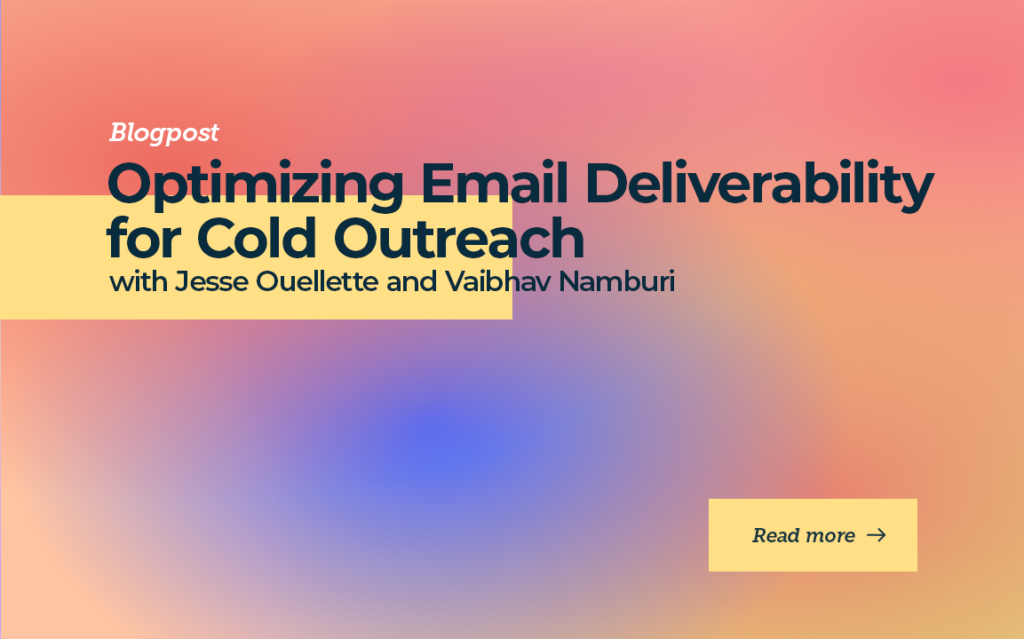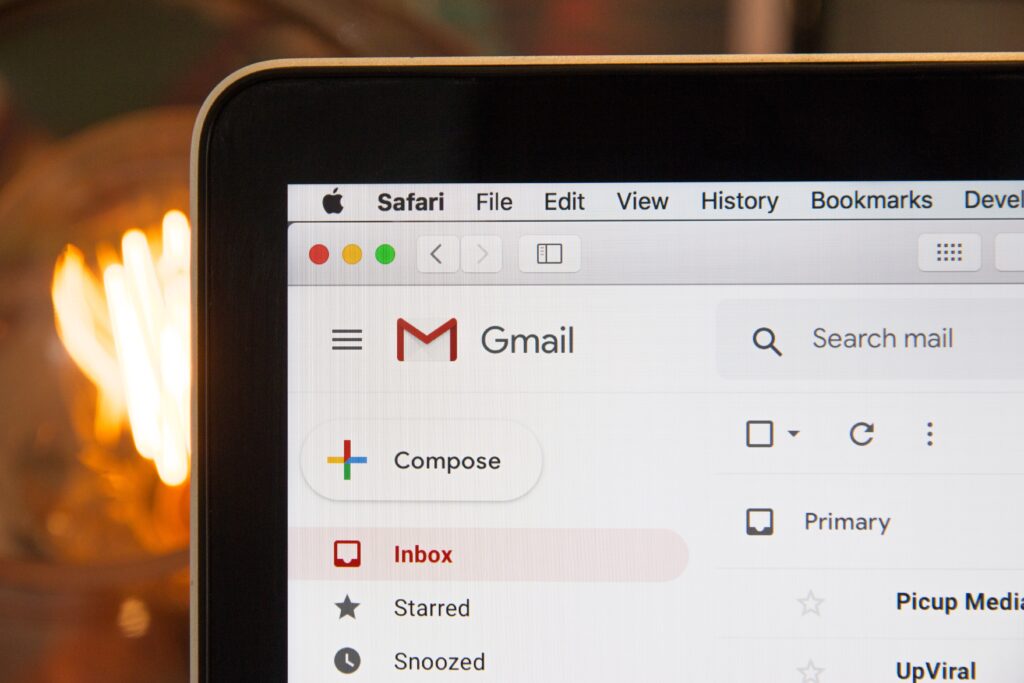Optimizing Email Deliverability for Cold Outreach with Jesse Ouellette and Vaibhav Namburi

Increased difficulty in cold email can be attributed to email clients prioritizing user experience and protecting customers’ primary inboxes. This poses a challenge for outreach efforts. However, rather than seeing it as a downfall, we view it as an exciting challenge to embrace.
Cold email, like sales, will always exist.
It may become more complicated, demanding expertise and effort, but it remains a valuable avenue for connecting with potential customers. Just as people mistakenly declare Facebook ads dead due to complexities, cold email thrives for those who understand its nuances.
Building a solid domain reputation and ensuring emails land in primary inboxes are crucial initial steps. Understanding client preferences, such as device usage or email client choices, further enhances success. Combining these factors makes cold email a strategic endeavor with immense potential.
Reply rates are crucial indicators of engagement and effectiveness.
One of the key insights that Jesse and Vaibhav shared is that tracking open rates alone is no longer an accurate measure of success. With increasing privacy concerns and tools like Apple’s mail protection policies, open rates have become a less reliable metric. Instead, the focus should shift toward tracking replies.
It’s essential to ask recipients questions or prompt them to act rather than distract them with unrelated links or videos. By utilizing email as the intended communication tool it was designed to be, businesses can leverage their inherent strengths and build strong connections.
Unlike social media platforms with strict regulations and monitoring, email provides greater freedom and control. There’s no need to create fake accounts or deal with algorithmic limitations. Instead, you can send emails directly as yourself and establish genuine connections with your audience.

To determine what metrics to track, aligning them with your specific goals is essential.
If your objective is to drive clicks, click-through rates become vital. On the other hand, if you aim to generate meaningful replies and engagement, reply rates hold greater significance.
When evaluating response rates, it’s crucial to differentiate between positive and negative responses. Positive responses indicate genuine interest and a potential opportunity for further interaction, while negative responses may include out-of-office replies or explicit disinterest.
As a general guideline, aiming for a 5% to 6% reply rate can be considered a positive benchmark. From those responses, a further goal of achieving a 5% to 15% positive response rate can provide insights into the level of interest and receptiveness to your message.
By focusing on these active engagement measurements, businesses can move beyond vanity metrics and better understand their email campaign’s effectiveness.
Suddenly, you’re not sure who’s clicking that pixel anymore.
Remember the good old days when you could peek at the user agent details? Well, Google decided to shake things up and hide that information from us, leaving us wondering what was happening behind the scenes.
The burning question emerges: Does Google automatically load that tracking pixel the moment we hit send? Or does it patiently wait for Jessie to open the email and then go, “Oh, let me download that image now”?
It turns out that the behavior depends on your browser settings, especially if we’re talking about Gmail. There’s this nifty option where the pixel gets loaded when you view the email. But hold on! When you throw in Apple’s private relay and all the proxy business, things get trickier.
Apple, the cool kid on the block, pre-renders the email content on their servers, leaving us clueless about what’s happening inside. It’s like a magician’s trick where the secrets disappear into thin air.
Google’s data may offer some insights, but the level of detail has dwindled. Log files are the stuff of dreams now, making it harder for us to get a complete picture.
How not to mess up the deliverability of your emails.
Those basic authentication mechanisms are crucial regarding your email delivery setup and settings. They need to be aligned correctly to avoid any issues. Many companies unintentionally install too many marketing automation systems, causing alignment collisions.
To check alignment, you can use tools like MX Toolbox. If you find that things are not lining up, it often means that the return path is not correct. This misalignment can land your emails in the spam folder, which we want to avoid.
Maintaining your email reputation is crucial, and volume plays a significant role.
Sales emails tend to receive real complaints, so it’s essential to handle them properly. Sending many emails from your domain and receiving a high percentage of complaints can raise suspicions. It’s vital to maintain a balanced volume across your infrastructure.
Consider using a separate domain name or limiting your daily sending volume for effective sales email campaigns. Your company’s reputation may suffer when engagement goes south, and you blast emails without proper control. You don’t want your emails to be blocked by major email providers.
In addition to SPF, DKIM, and DMARC, other factors boost deliverability. Sending patterns and frequency matter. Avoid sending emails at the same time and introduce natural variance. Create variations in content to improve deliverability.
Understanding why people say “no” to your offers is crucial.
It’s not always about targeting the right person based on your ideal customer profile (ICP) but also aligning your offer with their intent. For example, if you’re selling protein powder to vegans, they won’t be interested in non-vegan options. So, it’s essential to adapt your offer to match your target audience’s specific needs and preferences.
Instead of simply assuming that your ICP is incorrect when facing low interest or high spam scores, take the time to listen to why people are not interested. This allows you to refine your offer and improve its alignment with the target audience.
Flexibility is key. If you’re selling to a price-sensitive community, focus on competitive pricing. If you’re targeting value-based businesses, emphasize the impact on revenue.
In addition to understanding your audience, tools like G-Lock Apps, MailTester, or similar solutions can provide more realistic testing and insights into email deliverability. Alternatively, you can leverage equivalent tools available in the market to analyze your email campaigns and identify areas for improvement.
Note: The email deliverability landscape is constantly changing, and the information shared today might not be valid in the future. “This is the best time to send your cold emails.”
Timing is a crucial factor to consider when sending cold emails. However, it’s essential to approach such advice with caution. If everyone follows the same timing suggestion and floods recipients’ inboxes simultaneously, it becomes ineffective. Instead, it’s recommended to spread out your emails throughout the day for each domain. This way, you maintain a natural and balanced email sending pattern.
Many self-proclaimed experts on platforms like LinkedIn may proclaim the “best” time to send emails, like 8:05 AM. However, it’s important to exercise restraint and not exceed reasonable limits. Sending an excessive number of emails within a short period can lead to your messages being flagged as spam. It’s advisable to keep your email volume within a reasonable range, such as 20 to 30 emails, to maintain a healthy email reputation.
Even the advice we provide should be tested and validated by you. We encourage you to try different strategies and assess their effectiveness firsthand. Only by experimenting and drawing your own conclusions can you truly determine what works for your specific situation. It’s crucial to exercise caution when accepting advice from various sources, as blindly following recommendations can lead you down a rabbit hole of ineffective practices.
So, is cold email dead? No. It’s evolving.
It presents challenges that separate the committed from the casual. By adapting and truly understanding your audience, you can unlock untapped opportunities.
Personalization is key. Tailoring our offers to match the recipient’s needs is crucial for success. We shouldn’t blindly follow generic rules but be flexible and experiment. Timing matters, and spreading emails throughout the day per domain is more effective. Trustworthy advice is earned through testing, not blind trust. Cold email requires staying informed and proactive. Utilize tools like G-Lock Apps for spam score checking.
Cold email is an opportunity waiting to be seized. We can connect with our audience by adapting, targeting effectively, and embracing personalization.
NO TIME TO READ?
Listen On:




